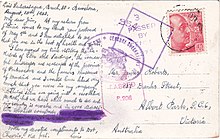Our website is made possible by displaying online advertisements to our visitors.
Please consider supporting us by disabling your ad blocker.
Postal censorship

Postal censorship is the inspection or examination of mail, most often by governments. It can include opening, reading and total or selective obliteration of letters and their contents, as well as covers, postcards, parcels and other postal packets. Postal censorship takes place primarily but not exclusively during wartime (even though the nation concerned may not be at war, e.g. Ireland during 1939–1945) and periods of unrest, and occasionally at other times, such as periods of civil disorder or of a state of emergency. Both covert and overt postal censorship have occurred.
Historically, postal censorship is an ancient practice; it is usually linked to espionage and intelligence gathering. Both civilian mail and military mail may be subject to censorship, and often different organisations perform censorship of these types of mail. In 20th-century wars the objectives of postal censorship encompassed economic warfare, security and intelligence.
The study of postal censorship is a philatelic topic of postal history.
Previous Page Next Page


